
The Ramayana, also known as Valmiki Ramayana, as traditionally attributed to Valmiki, is a smriti text from ancient India, one of the two important epics of Hinduism known as the Itihasas, the other being the Mahabharata. The epic narrates the life of Rama, a prince of Ayodhya in the kingdom of Kosala. The epic follows his fourteen-year exile to the forest urged by his father King Dasharatha, on the request of Rama's stepmother Kaikeyi; his travels across forests in the Indian subcontinent with his wife Sita and brother Lakshmana; the kidnapping of Sita by Ravana, the king of Lanka, that resulted in war; and Rama's eventual return to Ayodhya along with Sita to be crowned king amidst jubilation and celebration.

Ravana is a multi-headed rakshasa king of the island of Lanka, and the chief antagonist in the Hindu epic Ramayana. In the Ramayana, Ravana is described as the eldest son of sage Vishrava and Kaikasi. He abducted Prince Rama's wife, Sita, and took her to his kingdom of Lanka, where he held her in the Ashoka Vatika. Rama, with the support of vanara King Sugriva and his army of vanaras, launched an invasion against Ravana in Lanka. Ravana was subsequently slain, and Rama rescued his beloved wife Sita.
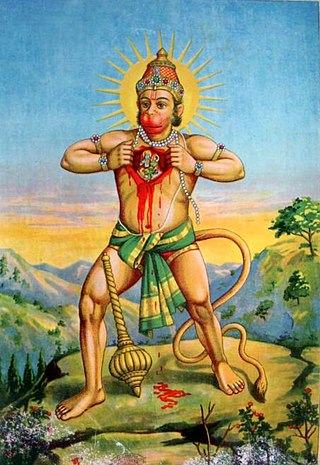
Hanuman, also known as Maruti, Bajrangabali, and Anjaneya, is a deity in Hinduism, revered as a divine vanara, and a devoted companion of the deity Rama. Central to the Ramayana, Hanuman is celebrated for his unwavering devotion to Rama and is considered a chiranjivi. He is traditionally believed to be the spiritual offspring of the wind deity Vayu, who is said to have played a significant role in his birth. In Shaiva tradition, he is regarded to be an incarnation of Shiva, while in most of the Vaishnava traditions he is the son and incarnation of Vayu. His tales are recounted not only in the Ramayana but also in the Mahabharata and various Puranas.
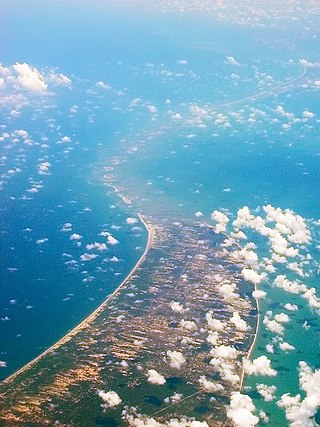
Adam's Bridge, also known as Rama's Bridge or Rama Setu, is a chain of natural limestone shoals between Pamban Island, also known as Rameswaram Island, off the south-eastern coast of Tamil Nadu, India, and Mannar Island, off the north-western coast of Sri Lanka. Geological evidence suggests that the bridge was formerly a land connection between India and Sri Lanka.
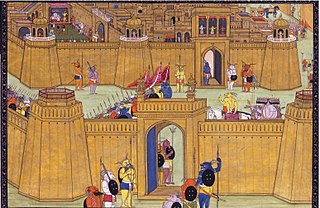
Lanka is the name given in Hindu epics to the island fortress capital of the legendary asura king Ravana in the epics of the Ramayana and the Mahabharata. The fortress was situated on a plateau between three mountain peaks known as the Trikuta Mountains. The ancient city of Lankapura is said to have been burnt down by Hanuman. After its king, Ravana was killed by Rama with the help of Ravana's brother Vibhishana, the latter was crowned king of Lankapura. His descendants were said to still rule the kingdom during the period of the Pandavas. According to the Mahabharata, the Pandava Sahadeva visited this kingdom during his southern military campaign for the rajasuya of Yudhishthira. The palaces of Ravana were said to be guarded by four-tusked elephants.
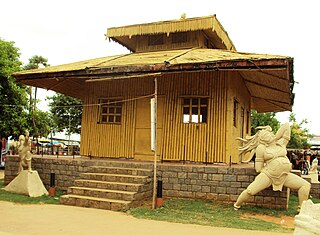
Parnasala is a village in the Dummugudem mandal in the newly formed Bhadradri Kothagudem district of Telangana, India. The village is accessible by road and boats and is situated 32 km from the temple town of Bhadrachalam.

Ramcharitmanas, is an epic poem in the Awadhi language, composed by the 16th-century Indian bhakti poet Tulsidas. It has many inspirations, the primary being the Ramayana of Valmiki.

Vibhishana is the younger brother of Ravana, the King of Lanka, in the ancient Indian epic Ramayana. Though a rakshasa himself, Vibhishana turned his back on Ravana, and defected to Rama's side, owing to his dharma. After Rama defeated Ravana, the former crowned Prince Vibhishana as the King of Lanka before returning to Ayodhya.

Sita, also known as Siya, Janaki, Maithili, Vaidehi and Bhumija, is a Hindu goddess and the female protagonist of the Hindu epic, Ramayana. She is the consort of Rama, the avatar of the god Vishnu, and is regarded as an avatar of Vishnu's consort, Lakshmi. She is also the chief goddess of Rama-centric Hindu traditions. Sita is known for her dedication, self-sacrifice, courage, and purity.
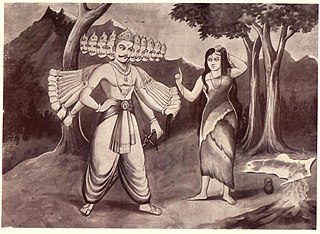
Vedavati is the previous birth of the goddess Sita in Hindu mythology. She is an avatar of the goddess of prosperity, Lakshmi.
Tharaka was a mythological king from Sri Lanka.

Meemure is a village with a population of about 420 people living in it It is located near the border between Kandy District and Matale District in the Knuckles Mountain Range. Meemure is one of the most remote villages in Sri Lanka with the only access via a 14 km (8.7 mi) trail from the town of Loolwatte. There is no cellular service available in the village, but a CDMA telephone service is available. There is no direct mail delivery to the village; a villager journeys each day to Thapal Junction to exchange incoming and outgoing postal mail with a postman.

Ashoka Vatika is a grove in Lanka that is located in the kingdom of the rakshasa king Ravana. It is mentioned in the Vishnu Purana and the Hindu epic Ramayana of Valmiki, and all subsequent versions, including the Ramacharitamanas written by Tulsidas, where it finds mention in the Sundara Kanda. The Vatika has garden houses around it, built by Vishvakarma himself.

Ravana Falls is a popular sightseeing attraction in Uva province of Sri Lanka. It currently ranks as one of the widest falls in the country.
Thiruputkuzhi is a small temple town in Tamil Nadu, India. It is situated about 7 miles west of Kanchipuram and half a kilometre from Baluchetti Chattiram which lies on the Chennai - Vellore highway. The place is known after the Vijayaraghava Perumal temple.

Ritigala is a mountain in central Sri Lanka which is home to an ancient Buddhist monastery. The ruins and rock inscriptions of the monastery date back to 1st century BCE. It is located 43 km (27 mi) away from the ancient monastic city of Anuradhapura.

The Seetha Amman Temple is a Hindu temple located in Seetha Eliya village approximately 1 kilometre (0.62 mi) from Hakgala Botanical Garden and 5 kilometres (3.1 mi) from Nuwara Eliya.
Wariyapola (වාරියපොල) is a town in the Kurunegala District, North Western province, Sri Lanka. Wariyapola is 94 metres (308 ft) above the sea level. Wariyapola is mostly known by sri Lankans because of the Wariyapola Sri Sumangala Tero, who take down the Union Jack and re-hoisting the Sinhalese lion flag, before the convention that handed over control of the island to the British in 1815.

In some adaptations of the Hindu epic Ramayana, Maya Sita or Chaya Sita is the illusionary duplicate of the goddess Sita, who is abducted by the demon-king Ravana of Lanka instead of the real Sita.

Panduwasnuwara is an ancient capital, situated in Kurunegala District, Sri Lanka. It is said to be the controlling centre known as Parakramapura of Dakkhinadesa in the 12th century, when it was ruled by Parakramabahu. The remaining ruins of the ancient kingdom still can be seen at Kotampitiya area which lies along Wariyapola-Chilaw main road about 19 km (12 mi) away from Wariyapola town. Panduvasnuwara is located at a distance of 3 km from Hettipola and 18 km from Kuliyapitiya.
















